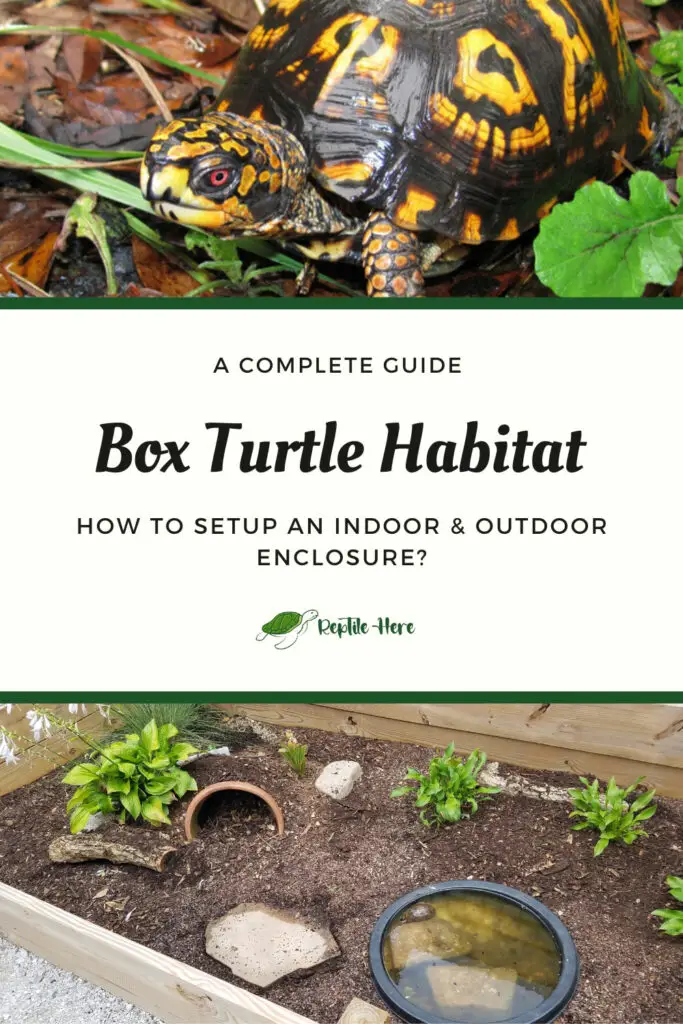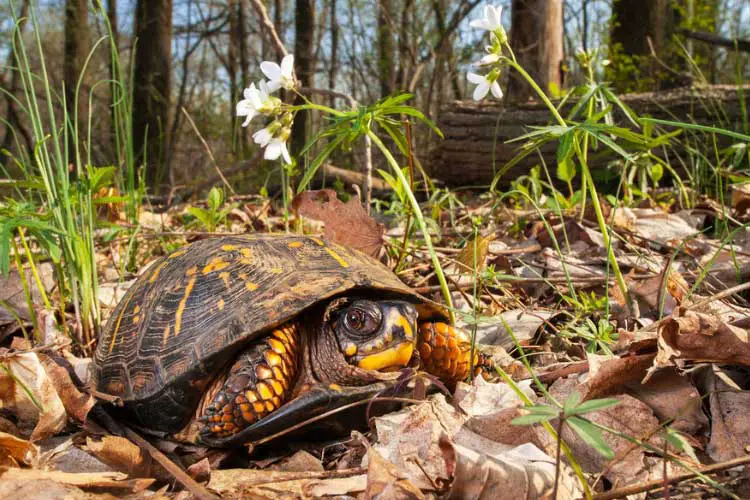Box Turtle Habitat: How to Setup an Indoor & Outdoor Enclosure?
You can set up a habitat for your box turtle pet indoors or outdoors. If this is your first time setting up a habitat for this turtle, then you need to be careful to avoid making mistakes that end up costing your turtle’s health and life.
The perfect box turtle habitat comprises a spacious enclosure, proper lighting, substrate, live plants, a water bowl, hiding spots, and a hygrometer for monitoring the humidity levels.
This guide will teach you step-by-step how to set up a beautiful home for your pet turtle, where it can live happily and comfortably. Whether you decide to do an outdoor or indoor enclosure, this guide has got you covered.
How to set up an indoor box turtle habitat
Contents
Box turtles generally live in a land-based environment filled with vegetation, shrubs, etc., and like soaking in shallow waters from time to time.
So, an ideal indoor box turtle enclosure should be land-based, with small plants or moist leaves plus a small area to drink water.
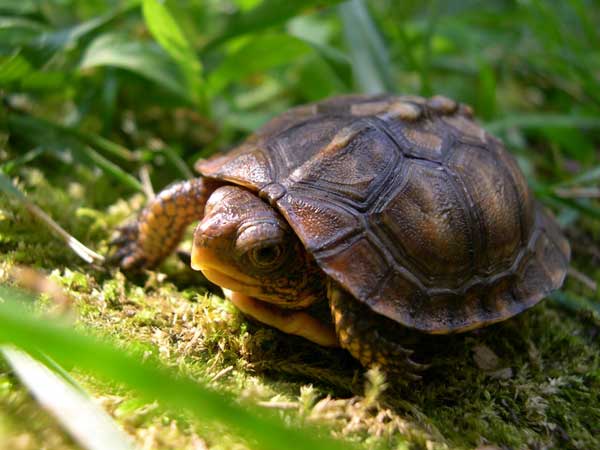
What you’ll need when setting up indoor box turtle habitat:
- Enclosure
- Substrate
- UVB Lighting
- Heat lamp
- Live plants
- Hiding spots
- Water container
- Thermometer & hygrometer
How to set up an indoor box turtle enclosure:
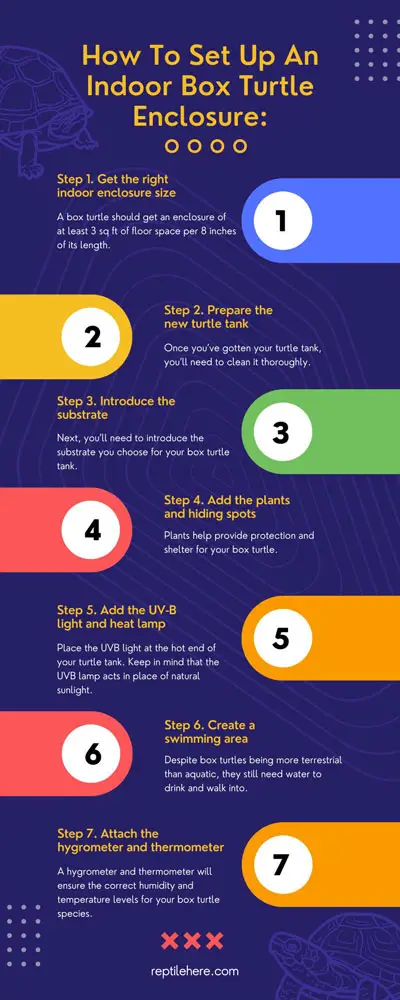
Step 1. Get the right indoor enclosure size
A box turtle should get an enclosure of at least 3 sq ft of floor space per 8 inches of its length. That’s sufficient room for digging, roaming, and exploring.
Generally, box turtles require big tank sizes where they can freely roam. This is attributed to their terrestrial nature where they enjoy roaming freely in the wild
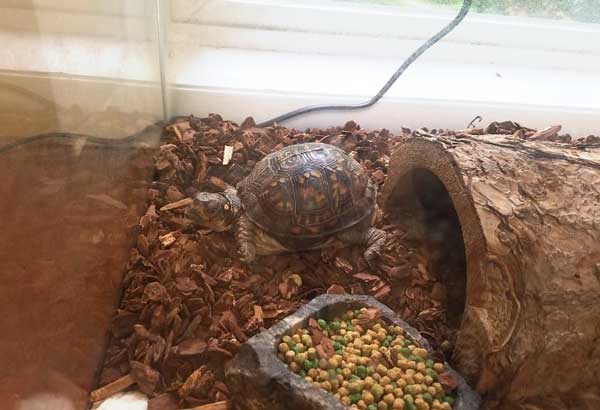
Step 2. Prepare the new turtle tank
Once you’ve gotten your turtle tank, you’ll need to clean it thoroughly. This will help get rid of any chemicals or products still attached to your brand-new tank.
These can cause illnesses and infections to your newfound friend, so make sure you clean the tank first. You can use bleach water solution to clean the tank and then air-dry it.
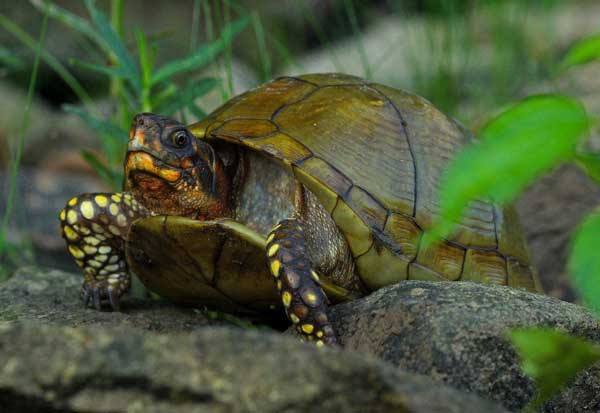
Also, you’ll need to divide your new turtle tank into hot and cool ends. This will make things easy for you in the rest of the steps below. You’ll know which side to place the other essentials on.
The cool side should be at the lower end of the box turtle’s recommended enclosure temperature range. There should be no lighting at this end. The hot end should feature your box turtle’s UV-B lighting as well as a basking spot.
Step 3. Introduce the substrate
Next, you’ll need to introduce the substrate you choose for your box turtle tank. There are plenty of substrate combinations and options to choose from.
You can go with something basic such as organic soil plus coconut fiber and/or cypress mulch combination. You can then add sphagnum moss or bark on top to give it a natural look.
We recommend choosing a substrate that feels a bit hard. Lose substrate, e.g. soil alone, can easily spread everywhere in your enclosure and even into the water cup. Plants will also have a hard time thriving in such a substrate.
Step 4. Add the plants and hiding spots
Plants help provide protection and shelter for your box turtle. The best plants to consider include alfalfa, strawberry plants, clover, etc. And some of the plants to avoid include potato, rhubarb, tobacco, ivy, and tomato plants/leaves.
Creating hiding spots in your turtle enclosure is also recommended to make the enclosure more diverse. To create hideaways, use items like logs and stone, or get a hide box. Create as many hiding spots as possible for your box turtle.
Step 5. Add the UV-B light and heat lamp
Place the UVB light at the hot end of your turtle tank. Keep in mind that the UVB lamp acts in place of natural sunlight, helping your turtles get UVB rays they require to synthesize vitamin D3 and facilitate proper calcium absorption.
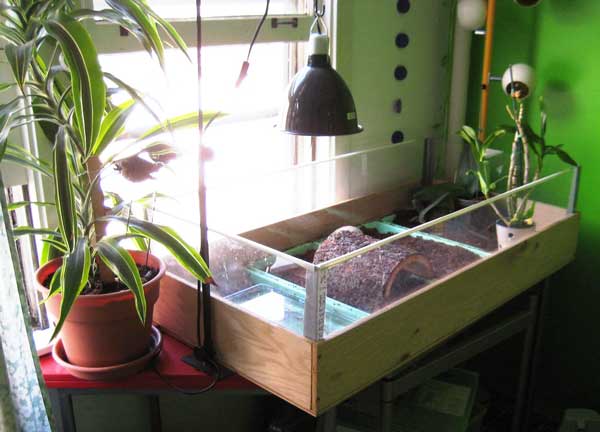
Also, install a heat lamp at the hot end of your turtle enclosure. This will create the warm side of your enclosure. It helps keep your turtle warm during basking. Put a thermometer under this heat source and ensure it reads around 85 degrees F.
Step 6. Create a swimming area
Despite box turtles being more terrestrial than aquatic, they still need water to drink and walk into. If possible, you should provide your pet with an even bigger area filled with water where they can easily soak in.
But make sure the water container is shallow enough for your box turtle to easily climb out. Also, avoid putting water near the lighting, otherwise, you may heat it up a bit too much for your little friend’s body to handle.
Step 7. Attach the hygrometer and thermometer
A hygrometer and thermometer will ensure the correct humidity and temperature levels for your box turtle species. If the heat and moisture levels in your turtle enclosure aren’t monitored, your turtle’s health and lifespan can be greatly affected.
So, where do you position these helpful tools? You should place the thermometer and hygrometer at the cool end of your enclosure. This will ensure you obtain more accurate readings for temperature and heat.
How to set up an outdoor box turtle habitat
An outdoor box turtle habitat ensures your pet turtle gets maximum sunlight exposure, which is the best source of UVB rays.
However, this kind of enclosure needs to be predator-proof to keep away dogs, foxes, raccoons, etc., from attaching your pet.
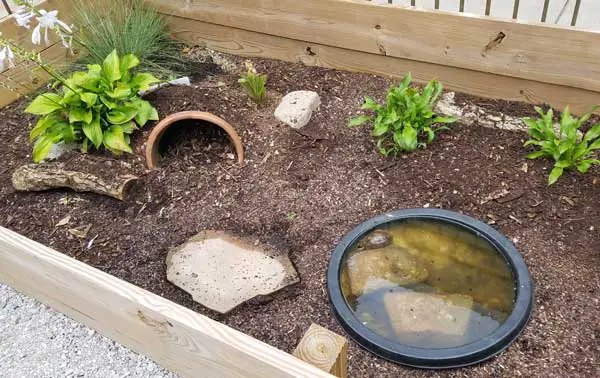
Things you’ll need for an outdoor box turtle enclosure:
- Enclosure
- Substrate
- Plants
- Heat and Light
- Hiding spots
- Water bowl
How to set up an outdoor box turtle enclosure:
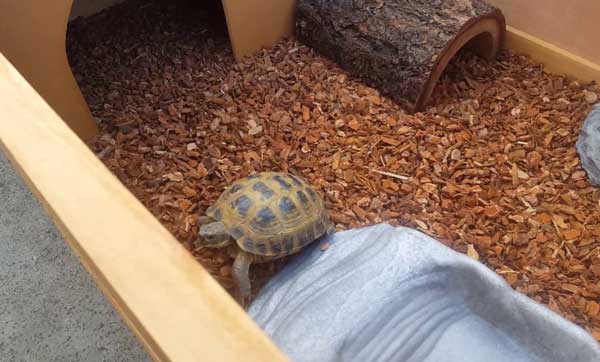
Step 1. Get the right type and size of outdoor enclosure
An ideal outdoor enclosure for your box turtle should be enclosed to keep out predators and prevent your turtle from escaping. Box turtles are good at digging, so you should also dig the enclosure into the ground to keep your turtle from escaping by digging.
A good example of an enclosure for outdoor use is an animal cage such as a dog crate. You may also go with a wooden house made with untreated wood, or an enclosure made from cement blocks.
Whatever enclosure you choose, ensure it offers you easy access to provide food and shelter to the turtle.
The outdoor box turtle enclosure should also be big enough for your turtle to freely roam around without feeling cramped up. The experts recommend getting a minimum 4 x 8 ft. enclosure; this is especially helpful if you have more box turtles.
However, if you’ve limited space and own 1-2 box turtles only, then get at least a 4x4ft enclosure.
Step 2. Add the substrate
Choosing a substrate that helps retain both heat and moisture for your outdoor enclosure. We recommend using organic soil, coconut fiber chips, or various types of moss. If you like, you can also mix these substrates.
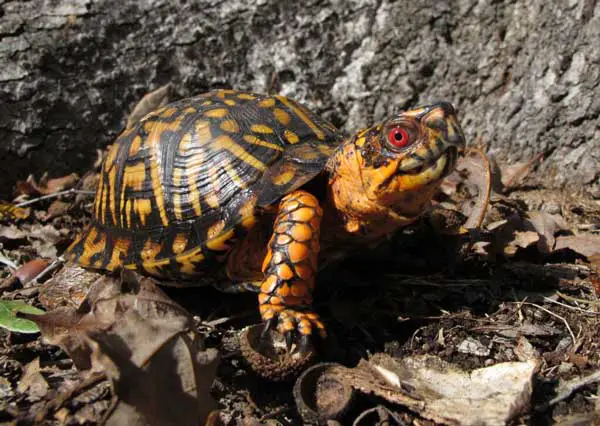
Turtles like digging, so you’d want to make sure you get a substrate that’s loose (but not too loose) for your friend to dig up and burrow into when the water gets warm or during hibernation.
Step 3. Introduce water bowl
Similar to the indoor enclosure, your outdoor turtle habitat will also need a shallow water container where they can hydrate, release waste, and even swim to regulate their body temperatures.
Ensure the bowl is large enough for your turtles to sit inside and shallow enough for the turtles to easily climb out. Try sinking the water bowl into the gravel areas of your substrate where the turtles can easily get in and out without making it turn muddy easily.
Step 4. Add plants to the enclosure
Plant your new enclosure with non-toxic box turtle plants such as kale, parsley, collard greens, strawberries, raspberries, alfalfa, clover, etc.
Since box turtles are omnivorous, these plants will offer them food. They’ll also feed on the worms and insects on these plants.
Step 5. Create hiding spots
Hideaways for your outdoor enclosure will give your turtle a place to crawl into and hide. They also offer them a place to get shade and regulate their body temperature.
Some of the best hideaway spots to consider include a half log, plant pots dug into the ground with the bottom facing up and a little hole created, wooden boxes, etc.
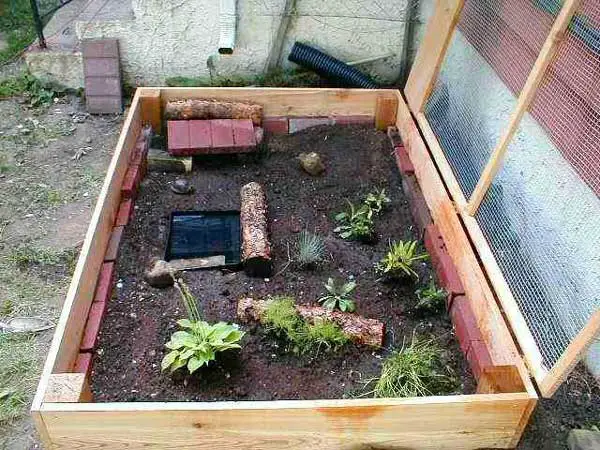
Regardless of the type of hide you use, make sure it’s big enough for your turtle. If you keep many turtles, make sure you provide a hide for each of them.
Final Verdict
An ideal box turtle habitat should mimic its natural or wild habitat whether you set it indoors or outdoors. It should be spacious and feature plenty of substrates, live plants, hiding areas, and a water station where your pet can hydrate or soak in water. The humidity and temperature aspects should also match those of box turtle habitats in the wild.
We hope that this guide has provided you with all the information you need on how to set up a comfortable living space for your pet box turtle indoors or indoors. Keep in mind that the outdoor enclosure is better than the indoor one as it offers an even more natural habitat for your pet with exposure to direct sunlight.
